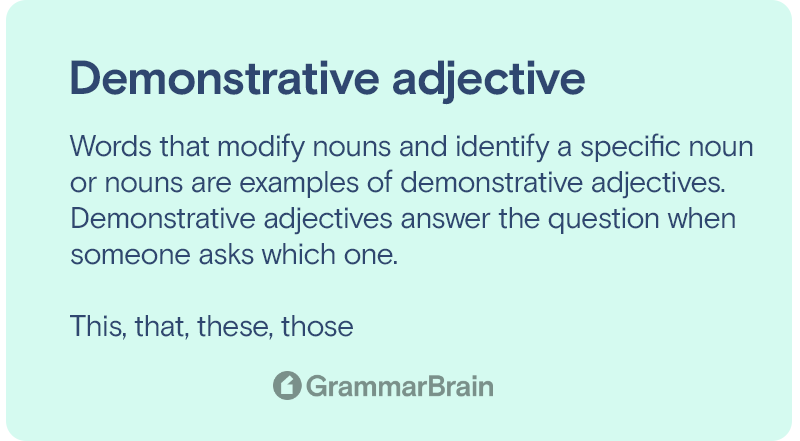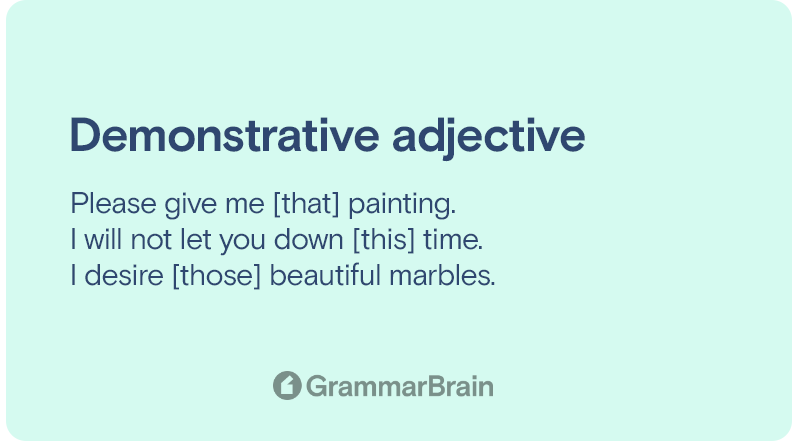What is a demonstrative adjective? We employ adjectives to describe and characterize pronouns and nouns. Although there are numerous types of adjectives, this article will delve into the depth of one extremely fascinating adjective, i.e., demonstrative adjectives.

What is a demonstrative adjective?
Words that modify nouns and identify a specific noun or nouns are examples of demonstrative adjectives. Demonstrative adjectives answer the question when someone asks which one.
Here’s an example of a statement without a demonstrative adjective:
- The tree looks stunning.
The tree looks stunning would be an extremely perplexing statement if the speaker were in the middle of a jungle. The audience may wonder, “Which tree?”
Here’s an example of a statement containing a demonstrative adjective.
- That tree looks stunning.
This statement clears up any ambiguity and specifies a particular tree. Which tree is the most stunning? That particular tree.
Definition of a demonstrative adjective
Demonstrative adjectives are defined as follows:
A term directly refers to a thing/ person or a group of persons and things. Since demonstrative adjectives are only four in number, they are easy to remember for future use.
Demonstrative Adjectives List:
- This
- That
- These
- Those
How is a demonstrative adjective different from a regular adjective?
The demonstrative adjectives this, that, these, and those, unlike the majority of adjectives, may be used like demonstrative pronouns, for instance, in the statement This is a calamity.
Furthermore, demonstrative adjectives cannot be employed to make comparative or superlative adjectives. Something can be heavier (the comparative adjective of heavy) than something else, but not “these-er” or “that-er” than something else.
While these characteristics may justify defining demonstrative adjectives as a separate figure of speech, we regard the terms that, this, and those when employed as demonstrative adjectives. And these to be adjectives.
Although it’s not like every style guide will adhere to this approach, therefore don’t be shocked if the terms that, this, those. And these are referred to as demonstrative pronouns or even determiners when employed as adjectives.

Demonstrative adjective examples
Below are some examples of demonstrative adjectives:
- Please give me that painting.
- I will not let you down this time.
- I desire those beautiful marbles.
- That day, I had planned to propose to you.
- These mangoes are turning brown.
- I’ll never forget this day in my life.
- Those guys were cruel to her.
- I cannot give you money at this point in my life.
- I cannot do this for you.
- Those rogues have returned to town.
- This pen glides more smoothly than another pen.
- Will you please return the money that I gave you?
- That structure is more durable than this cabin.
- I’m going to buy this cottage because I find it more appealing.
Note the use of this, that, these, those.
How to identify a demonstrative adjective?
One basic principle to identify demonstrative adjectives is that they can only be employed to modify pronouns or nouns.
They always apply before the nouns they change, and they are always used first in adjective order.
This will be clearer with an example:
- Incorrect: I want to hug lovely cat that.
- Incorrect: I want to hug lovely that cat.
- Incorrect: I want to hug that lovely cat.
How to use a demonstrative adjective
There are two ways in which we can use demonstrative adjectives.
Demonstrative adjectives are employed to clarify the physical location of a thing that has some connection with the speaker. The adjectives “these” and “this” relates to items or persons nearby. Whereas the adjectives “those” and “that” describe people or objects that are farther away.
“That” and “this” are employed to modify singular nouns, whereas those and these are employed to modify plural nouns.
Assume you are in a bedroom with two dogs. One dog is blissfully licking your leg while the other is asleep on the ground opposite the bedroom. Your friend wants to know which dog you like the most.
Now, if you like the dog close to you, then you would reply, “I like this dog.” But if you like the dog far away, you will point towards it and say, “I like that dog.” In this situation, demonstrative adjectives assisted you in distinguishing between the two dogs based on their locations.
The second most common usage of demonstrative adjectives is to allude to specific points in time. As in the preceding instances, these and this are used to refer to present, recent, or imminent events in time.
In contrast, “those” and “that” are used to relate to events that happened or will take place in the future.
Examples:
- This day has been fantastic! (This denotes a day near the present)
- I recall that day as if it were yesterday. (This implies a day that happened many years ago)
- These next two Saturdays are going to be fantastic. (This means that the Events will take place soon.)
- When I think back on those difficult times, I used to smile. (This indicates that the events occurred in the past.)
Can numbers be demonstrative adjectives?
Ordinal numbers such as first, second, third, fourth, and fifth can function as demonstrative adjectives. Like other demonstrative adjectives, they show which noun we are talking about.
Below are some examples to understand this in more detail:
- My very first salary was just $400.
- Saturday is the sixth day of the week.
- I was hungry even after eating the sixth slice of pizza.
- We purchased a large cake for my mother’s fiftieth birthday celebration.
Cardinal numbers, also known as standard counting numbers, are not regarded as demonstrative adjectives; instead, they are descriptive adjectives.
Inside this article
Fact checked:
Content is rigorously reviewed by a team of qualified and experienced fact checkers. Fact checkers review articles for factual accuracy, relevance, and timeliness. Learn more.
Core lessons
Glossary
- Abstract Noun
- Accusative Case
- Anecdote
- Antonym
- Active Sentence
- Adverb
- Adjective
- Allegory
- Alliteration
- Adjective Clause
- Adjective Phrase
- Ampersand
- Anastrophe
- Adverbial Clause
- Appositive Phrase
- Clause
- Compound Adjective
- Complex Sentence
- Compound Words
- Compound Predicate
- Common Noun
- Comparative Adjective
- Comparative and Superlative
- Compound Noun
- Compound Subject
- Compound Sentence
- Copular Verb
- Collective Noun
- Colloquialism
- Conciseness
- Consonance
- Conditional
- Concrete Noun
- Conjunction
- Conjugation
- Conditional Sentence
- Comma Splice
- Correlative Conjunction
- Coordinating Conjunction
- Coordinate Adjective
- Cumulative Adjective
- Dative Case
- Determiner
- Declarative Sentence
- Declarative Statement
- Direct Object Pronoun
- Direct Object
- Diction
- Diphthong
- Dangling Modifier
- Demonstrative Pronoun
- Demonstrative Adjective
- Direct Characterization
- Definite Article
- Doublespeak
- False Dilemma Fallacy
- Future Perfect Progressive
- Future Simple
- Future Perfect Continuous
- Future Perfect
- First Conditional
- Irregular Adjective
- Irregular Verb
- Imperative Sentence
- Indefinite Article
- Intransitive Verb
- Introductory Phrase
- Indefinite Pronoun
- Indirect Characterization
- Interrogative Sentence
- Intensive Pronoun
- Inanimate Object
- Indefinite Tense
- Infinitive Phrase
- Interjection
- Intensifier
- Infinitive
- Indicative Mood
- Participle
- Parallelism
- Prepositional Phrase
- Past Simple Tense
- Past Continuous Tense
- Past Perfect Tense
- Past Progressive Tense
- Present Simple Tense
- Present Perfect Tense
- Personal Pronoun
- Personification
- Persuasive Writing
- Parallel Structure
- Phrasal Verb
- Predicate Adjective
- Predicate Nominative
- Phonetic Language
- Plural Noun
- Punctuation
- Punctuation Marks
- Preposition
- Preposition of Place
- Parts of Speech
- Possessive Adjective
- Possessive Determiner
- Possessive Case
- Possessive Noun
- Proper Adjective
- Proper Noun
- Present Participle
- Prefix
- Predicate



